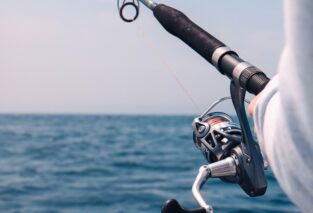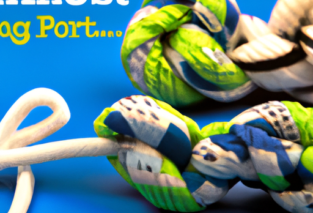In the world of fishing, a strong and secure knot can make all the difference between a successful catch and a frustrating escape. That’s why we are excited to introduce Fishing Knots 101: Tying The Perfect Knot For Your Catch. With this comprehensive guide, you will learn step-by-step instructions on how to tie a variety of knots specifically designed for different fishing situations. Whether you are a beginner or a seasoned angler, this product is your ultimate companion that will ensure your knots are strong, reliable, and secure, allowing you to focus on reeling in the big one. Get ready to take your fishing skills to the next level and never worry about knots failing you again!
1. Introduction to Fishing Knots
Welcome to Fishing Knots 101: Tying the Perfect Knot for Your Catch! As an avid angler, you know that using the right fishing knots is crucial for a successful fishing trip. Whether you’re a seasoned pro or just starting out, understanding the importance of selecting the right knot and how it affects the strength and durability of your fishing line is essential. In this comprehensive guide, we’ll explore various types of fishing knots, from basic to advanced, and even specialized knots. We’ll also share some tips and tricks to help you tie the perfect knot every time. So let’s dive in and discover the world of fishing knots together!

2. Basic Fishing Knots
2.1 Improved Clinch Knot
The Improved Clinch Knot is one of the most commonly used knots in fishing. It’s simple to tie and provides a strong and secure connection between your line and the hook or lure. To tie the Improved Clinch Knot, follow these steps:
- Thread the line through the eye of the hook and make 5-7 wraps around the standing line.
- Thread the loose end of the line through the loop near the eye of the hook.
- Hold the hook and standing line with one hand and the tag end with the other.
- Moisten the knot with saliva or water and pull the tag end to tighten the knot.
- Trim any excess line for a clean finish.
The Improved Clinch Knot is suitable for a variety of fishing scenarios, including freshwater and saltwater fishing. It’s particularly effective when using monofilament or fluorocarbon lines and small to medium-sized hooks.
2.2 Palomar Knot
Another popular knot among anglers is the Palomar Knot. This knot offers excellent strength and is particularly useful for attaching lures, swivels, and snaps to the fishing line. Here’s how to tie the Palomar Knot:
- Double about 6 inches of line and pass it through the eye of the hook or lure.
- Tie an overhand knot with the doubled line, creating a loop.
- Pass the hook or lure through the loop.
- Moisten the knot and pull both ends of the line to tighten it.
- Trim any excess line.
The Palomar Knot is known for its simplicity and reliability. It’s suitable for both braided and monofilament lines, making it a versatile choice for various fishing applications.
2.3 Uni Knot
The Uni Knot, also known as the Duncan Loop, is a versatile and easy-to-tie knot that works well with both monofilament and braided lines. It provides a strong and reliable connection and can be used for attaching hooks, lures, or swivels. Follow these steps to tie the Uni Knot:
- Run the line through the eye of the hook or lure, forming a loop with the tag end alongside the standing line.
- Take the tag end and make 4-6 wraps around the double line and through the loop.
- Moisten the knot and pull the tag end to tighten the wraps.
- Slide the knot down to the eye of the hook or lure by holding the standing line.
- Trim any excess line.
The Uni Knot is a go-to knot for many anglers due to its simplicity and strength. It can be used in various fishing scenarios, from freshwater to saltwater fishing.
2.4 Blood Knot
The Blood Knot is an excellent choice for joining two lines of equal diameter, such as when you need to add a leader to your main line. It creates a smooth and strong connection that easily passes through rod guides. To tie the Blood Knot, follow these steps:
- Overlap the ends of the two lines to be joined, ensuring they cross for about 6-8 inches.
- Take one end of a line and start wrapping it around the other line, making 5-7 wraps.
- Bring the loose end of the first line back through the middle loop you created.
- Repeat the same process with the other line, but wrap it in the opposite direction.
- Moisten the knot, hold both ends of the lines, and pull them tight, sliding the knot towards the intersection.
- Trim any excess line.
The Blood Knot is commonly used in situations where you need to join lines of similar diameters, such as when attaching a tippet to a leader in fly fishing. It’s a reliable knot that maintains a high percentage of the line’s breaking strength.

3. Advanced Fishing Knots
3.1 Double Uni Knot
If you need to join two lines of different diameters, the Double Uni Knot is an excellent choice. It creates a strong and secure connection that can withstand considerable tension. Follow these steps to tie the Double Uni Knot:
- Overlap the ends of the two lines to be joined for about 5-6 inches.
- Take the first line and double it back, forming a loop.
- Make 4-6 wraps with the doubled line around both the other line and its own double, going through the loop each time.
- Moisten the knot and pull the ends of both lines to tighten the knot evenly.
- Repeat the same process with the other line, but wrap it in the opposite direction.
- Moisten the knot and gently pull the tag ends to tighten both knots.
- Trim any excess line.
The Double Uni Knot is ideal for attaching a leader to a thicker main line, joining different types of lines, or creating a shock leader.
3.2 Surgeon’s Loop
The Surgeon’s Loop is a versatile knot that creates a strong loop at the end of your line. It’s perfect for creating a loop for attaching hooks, lures, or swivels, as well as for making dropper loops. Follow these steps to tie the Surgeon’s Loop:
- Create a small loop at the end of your line.
- Take the end of the loop and make a simple overhand knot around the standing line, passing it through the loop twice.
- Moisten the knot and pull it tight, ensuring both loops are snugly against each other.
- Trim any excess line.
The Surgeon’s Loop is easy to tie and provides good knot strength. It’s a reliable choice for creating loops quickly when you need to change hooks or lures frequently.
3.3 Albright Knot
The Albright Knot is a popular choice for joining lines of different diameters or materials. It creates a smooth and secure connection that easily passes through rod guides. Follow these steps to tie the Albright Knot:
- Overlap the ends of the two lines to be joined for about 10-12 inches.
- Take the tag end of the first line and make a few wraps around the second line and itself.
- Pass the tag end of the first line back through the loop created by the wraps.
- Moisten the knot and pull it tight, ensuring the wraps are snugly against each other.
- Trim any excess line.
The Albright Knot is widely used in scenarios where you need to attach a leader to a main line, such as in saltwater fishing or when targeting large, powerful fish.
3.4 FG Knot
The FG Knot is a popular choice among anglers using braided lines. It creates a slim and strong connection that easily passes through rod guides without any obstruction. Follow these steps to tie the FG Knot:
- Hold the standing line against the rod or a stationary object.
- Take the end of the braided line and start weaving it around the standing line, making 20-30 wraps.
- After completing the wraps, pass the tag end of the braided line through the first loop near the knot’s base.
- Hold both the tag end and standing line, and start pulling them simultaneously to tighten the knot.
- Trim any excess line.
The FG Knot is known for its exceptional knot strength and low profile, making it great for casting and preventing line damage or tangles.

4. Specialized Fishing Knots
4.1 Dropper Loop
The Dropper Loop is a versatile knot used in fly fishing, where multiple flies can be attached to the main line. It creates a loop that allows the flies to hang at different depths in the water. Follow these steps to tie the Dropper Loop:
- Create a small loop with the line, leaving a long tag end.
- Pass the tag end through the loop twice, making sure the loops are parallel.
- Hold the bottom loop and pull it down, tightening the knot.
- Moisten the knot and trim any excess line.
The Dropper Loop is an essential knot for anglers who want to maximize their chances of catching fish by presenting multiple flies at various depths simultaneously.
4.2 Bimini Twist
The Bimini Twist is a knot used to create a strong loop at the end of the line. It’s commonly used in big game fishing to create a double line for added strength. Follow these steps to tie the Bimini Twist:
- Create a large loop in the line, leaving a long tag end.
- Make 20-30 twists with the tag end around the double line.
- Pass the tag end through the loop you created.
- Moisten the knot and pull the tag end and standing line simultaneously to tighten the knot.
- Trim any excess line.
The Bimini Twist is a reliable knot that provides a strong loop capable of withstanding significant pressure. It’s particularly useful when targeting large, powerful fish.
4.3 Nail Knot
The Nail Knot is commonly used in fly fishing to attach the leader to the fly line. It creates a strong and smooth connection that easily passes through the guides. Follow these steps to tie the Nail Knot:
- Place the end of the leader and the end of the fly line parallel to each other, overlapping for about 8-10 inches.
- Hold the overlapped section and wrap the tag end of the leader around the fly line and itself, making 5-7 wraps.
- Pass the tag end of the leader through the loop created between the leader and fly line.
- Moisten the knot and pull the leader and fly line simultaneously to tighten the knot.
- Slide the wraps up towards the end of the fly line to make the knot compact.
- Trim any excess line.
The Nail Knot is a reliable and streamlined knot that joins the leader and fly line securely, allowing for smooth and accurate fly presentations.
4.4 Snell Knot
The Snell Knot is a popular choice for tying hooks to your fishing line. It creates a secure and direct connection that increases hook-up rates. Follow these steps to tie the Snell Knot:
- Insert the tag end of the line through the eye of the hook, pointing the hook shank upward.
- Hold the tag end and wrap it around the shank of the hook and line, making 6-8 wraps.
- Pass the tag end of the line through the eye of the hook in the opposite direction it entered.
- Moisten the knot and pull the tag end to tighten the wraps.
- Trim any excess line.
The Snell Knot is specifically designed for hooks with an offset or upturned eye. It ensures the hook is positioned correctly for effective hook sets.

5. Tips and Tricks for Tying Fishing Knots
5.1 Using Lubrication to Improve Knot Strength
Using a lubricant like saliva or water when tying fishing knots can significantly increase their strength and reduce friction. The lubrication helps the knot tighten smoothly and evenly, preventing it from weakening or breaking during a fight with a fish.
5.2 Ensuring Proper Tension and Tightness
When tying fishing knots, it’s crucial to maintain the right tension and tightness. Applying too much force can weaken the line or distort the knot, while insufficient tension can result in loose knots that easily come undone. Practice finding the perfect balance to ensure your knots are secure and reliable.
5.3 Trimming Excess Line for a Clean Finish
After tying a fishing knot, trim any excess line close to the knot for a clean and streamlined finish. This not only reduces the chance of tangles and snags but also helps your knots pass smoothly through rod guides, enabling longer and more accurate casts.
5.4 Testing Knots for Reliability
Before heading out on your fishing expedition, always test your knots for reliability. Give each knot a firm tug to ensure it holds without slipping or breaking. This simple test can save you from disappointment or a lost fish while on the water.
5.5 Practicing Knot Tying Before Hitting the Water
Like any skill, tying fishing knots requires practice to perfect. Take the time to practice tying various knots before heading out on your fishing trip. Familiarize yourself with the different steps, intricacies, and variations of each knot. With practice, you’ll become more proficient and confident in tying knots quickly and effectively.

6. Conclusion
In conclusion, understanding the importance of using appropriate fishing knots is crucial for any angler. The right knot can make the difference between a successful catch and a lost opportunity. From basic knots like the Improved Clinch Knot and Palomar Knot, to advanced knots like the Double Uni Knot and FG Knot, each knot serves a specific purpose and offers unique benefits. Additionally, specialized knots like the Dropper Loop and Bimini Twist cater to specific fishing techniques and conditions.
Remember to consider the type of line, hook/lure, and fishing scenario when choosing the appropriate knot. Don’t forget to utilize tips and tricks such as using lubrication, proper tension, trimming excess line, testing knot reliability, and practicing knot tying. With this comprehensive guide and a little practice, you’ll be well-equipped to tie the perfect knot for your catch. So go out there with confidence and enjoy the art of knot tying in your fishing adventures!





